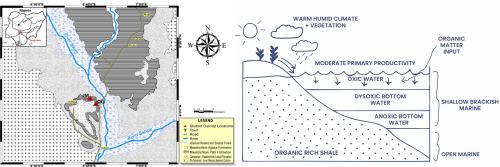Uncovering the Late Cretaceous paleoenvironment and paleoclimate of the Agbaja Plateau, Bida Basin, Nigeria: An inorganic geochemical analysis of shales and implications for organic matter enrichment
引用次数: 0
Abstract
The bulk geochemical composition of the shale samples of the Maastrichtian Patti Formation exposed at the Agbaja Plateau, southern Bida Basin, Nigeria was studied using X-ray fluorescence (XRF) and inductive coupled plasma mass spectrophotometry (ICPMS) techniques. The objectives of this study are to decipher their paleoenvironment, palaeoclimate and examine the influence of the paleogeographic conditions on the hydrocarbon source rock potential. The geochemical proxies indicate that the shales were deposited under oxic and warm and humid conditions. The plots of V/(V + Ni) vs. U/Th and Ni/Co vs. U/Th support the oxic setting for the shales. The slight Ce anomalies (0.93–1.26), ΣREE (39.40–1607.37 ppm) and (La/Yb)N ratio (4.11–10.78 ppm) are in support of the sub-oxic to oxic condition. The studied shales show Th/U values from 1.98 to 4.38 which indicates prevalence of high primary paleoproductivity. The clustering of the analyzed samples near the A-K line in the A-CN-K (Al2O3-CaO + Na2O-K2O) ternary diagram depicts an intense chemical weathering in the source region. In conclusion, the obtained paleogeographic scenario in the study area (warm temperature, high precipitation, oxic to dysoxic condition, and moderate to high primary paleoproductivity) typical of the west Africa upper Cretaceous and freshwater to brackish water environment would have supported the development of moderate organic matter rich source beds with potential for gas and oil in the Bida Basin. This study has underscored the significance of understanding the interplay between sedimentary environment, organic productivity and organic matter enrichment in predicting and exploring hydrocarbon source rocks.

揭示尼日利亚比达盆地Agbaja高原晚白垩世古环境和古气候:页岩无机地球化学分析及其有机质富集意义
利用x射线荧光(XRF)和电感耦合等离子体质分光光度(ICPMS)技术研究了尼日利亚Bida盆地南部Agbaja高原Maastrichtian Patti组页岩样品的整体地球化学组成。本研究的目的是破译其古环境、古气候,探讨古地理条件对烃源岩潜力的影响。地球化学指标表明,页岩沉积在缺氧和温暖潮湿的条件下。V/(V + Ni) vs. U/Th和Ni/Co vs. U/Th图支持页岩的氧化环境。微量Ce异常(0.93 ~ 1.26)、ΣREE异常(39.40 ~ 1607.37 ppm)和La/Yb N异常(4.11 ~ 10.78 ppm)支持亚氧—氧条件。研究页岩Th/U值为1.98 ~ 4.38,具有较高的原生古生产力。在A-CN-K (Al2O3-CaO + Na2O-K2O)三元图中,分析样品在A-K线附近聚集,说明源区化学风化作用强烈。综上所述,研究区典型的西非上白垩统、淡水-微咸水环境(温、高降水、缺氧-缺氧、初级古生产力中-高)古地理情景支持了比达盆地中富有机质、具油气潜力的烃源层发育。该研究强调了认识沉积环境、有机质生产力和有机质富集之间的相互作用对烃源岩预测和勘探的重要意义。
本文章由计算机程序翻译,如有差异,请以英文原文为准。
求助全文
约1分钟内获得全文
求助全文

 求助内容:
求助内容: 应助结果提醒方式:
应助结果提醒方式:


